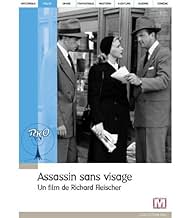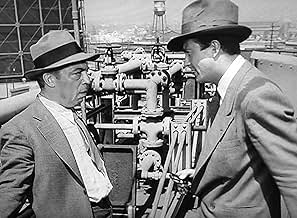IMDb-BEWERTUNG
6,5/10
2046
IHRE BEWERTUNG
Füge eine Handlung in deiner Sprache hinzuAn obsessed cop tracks an elusive serial killer who strangles his victims on rainy nights.An obsessed cop tracks an elusive serial killer who strangles his victims on rainy nights.An obsessed cop tracks an elusive serial killer who strangles his victims on rainy nights.
Archie Twitchell
- Dixon
- (as Michael Branden)
Fred Aldrich
- Detective at Briefing
- (Nicht genannt)
Walden Boyle
- Intern
- (Nicht genannt)
Paul Bryar
- Sgt. Bryce
- (Nicht genannt)
Wanda Cantlon
- Waitress
- (Nicht genannt)
Maurice Cass
- Bookstore Owner
- (Nicht genannt)
Martin Cichy
- Cop
- (Nicht genannt)
Art Dupuis
- Detective
- (Nicht genannt)
Handlung
WUSSTEST DU SCHON:
- WissenswertesFilmed in only sixteen days.
- PatzerWhen Detective Grant is in the office trying to solve the serial killings; he begins talking to the "Judge" dummy that is sitting on a chair with its back turned to him. After Collins interrupts him and they both leave the office; the dummy comes to life. It turns out that the real killer hid the dummy and took its place sitting on the chair. The puzzling thing is that the film does not explain how the killer manages to enter the Police precinct and the Detective's office without being detected. In addition, why would the killer want to go there and how did the killer in the first place even know the existence of a lookalike dummy. Finally, Detective Grant has been practically living with this dummy so it makes no sense that he couldn't tell even from the back that it was a real human being there. All these factors briefly interrupted the flow of the story.
- Zitate
Lt. Harry Grant: Funny thing how he always strikes in the rain.
Sgt. Art Collins: Maybe he likes rain. Must be a fish.
- VerbindungenFeatured in Armored Car Robbery (1950)
Ausgewählte Rezension
It's been a long time since I last saw Richard Fleischer's "Follow Me Quietly" on TV with commercial breaks making it seem longer than its 60 minute running time.
Looking at it again last week via a Warner Archive DVD that sure looks a lot better than the copy I saw years ago, my first reaction was one of "style over substance" but that's hardly a knock, and actually common for me when it comes to noir. This is really a programmer showing the talent of a director with aspirations, or as Fleischer claimed "This is the film that, above all, increased my knowledge of the trade. I learned how to organize a film." One can see that he was handed a script that is fairly routine, despite Anthony Mann sharing the credit for story. But Fleischer manages to add a few touches here and there to make an impression. The bit in policeman William Lundigan's apartment with the female reporter trying to get some story leads is quite suggestive although the two don't even so much as get into a clinch.
Lundigan, along with partner Jeff Corey, are on the trail of a serial killer known only as "The Judge" and in piling up what few clues they have, they manage to create a dummy that is the killer's size and appropriately dressed based on thread samples found - it's just missing a face. One eerie segment has Lundigan talking to the dummy until Corey walks in and warns him that he's bordering on being as crazy as the killer. But the scene doesn't end there however you'll have to watch it without my spoilers. I will say that here Fleischer does demonstrate his awareness that a film can be more than the sum of its parts.
However that point is teased several times in the film - that Lundigan and the killer may be of the same ilk. Lundigan is so unhinged perhaps to even allow a suspect who is confessing to demonstrate the method of strangulation that he used on a victim. Douglas Spencer makes good use of his minimal screen time in this segment. Even a waitress comments on a pattern of behavior that the cop shares with the criminal.
As Howard Hawks has said, a good film should have three good scenes and no boring scenes. In that respect, Fleischer doesn't let us down, even if a few scenes are the clichéd montage bits of cops pursuing leads, interviewing and pounding the pavement. You have to move the action forward somehow, even in a film that runs only an hour.
There's a mix of location shots (especially good in the finale) and studio sets to represent what we can presume to be Los Angeles. I'm just about certain that "The Judge" lived on the same block that Peter Lorre terrorized in "Stranger on the Third Floor." Dorothy Patrick plays the plucky reporter, she's quite appealing and manages to stay out of the way when told and thus avoiding the need for the cop to rescue the clueless female. In fact she's quite helpful when Lundigan gets a new lead and it's he who struck me as clueless on this point. Jeff Corey shines as Lundigan's partner and walks away with the film with ease.
Looking at it again last week via a Warner Archive DVD that sure looks a lot better than the copy I saw years ago, my first reaction was one of "style over substance" but that's hardly a knock, and actually common for me when it comes to noir. This is really a programmer showing the talent of a director with aspirations, or as Fleischer claimed "This is the film that, above all, increased my knowledge of the trade. I learned how to organize a film." One can see that he was handed a script that is fairly routine, despite Anthony Mann sharing the credit for story. But Fleischer manages to add a few touches here and there to make an impression. The bit in policeman William Lundigan's apartment with the female reporter trying to get some story leads is quite suggestive although the two don't even so much as get into a clinch.
Lundigan, along with partner Jeff Corey, are on the trail of a serial killer known only as "The Judge" and in piling up what few clues they have, they manage to create a dummy that is the killer's size and appropriately dressed based on thread samples found - it's just missing a face. One eerie segment has Lundigan talking to the dummy until Corey walks in and warns him that he's bordering on being as crazy as the killer. But the scene doesn't end there however you'll have to watch it without my spoilers. I will say that here Fleischer does demonstrate his awareness that a film can be more than the sum of its parts.
However that point is teased several times in the film - that Lundigan and the killer may be of the same ilk. Lundigan is so unhinged perhaps to even allow a suspect who is confessing to demonstrate the method of strangulation that he used on a victim. Douglas Spencer makes good use of his minimal screen time in this segment. Even a waitress comments on a pattern of behavior that the cop shares with the criminal.
As Howard Hawks has said, a good film should have three good scenes and no boring scenes. In that respect, Fleischer doesn't let us down, even if a few scenes are the clichéd montage bits of cops pursuing leads, interviewing and pounding the pavement. You have to move the action forward somehow, even in a film that runs only an hour.
There's a mix of location shots (especially good in the finale) and studio sets to represent what we can presume to be Los Angeles. I'm just about certain that "The Judge" lived on the same block that Peter Lorre terrorized in "Stranger on the Third Floor." Dorothy Patrick plays the plucky reporter, she's quite appealing and manages to stay out of the way when told and thus avoiding the need for the cop to rescue the clueless female. In fact she's quite helpful when Lundigan gets a new lead and it's he who struck me as clueless on this point. Jeff Corey shines as Lundigan's partner and walks away with the film with ease.
Top-Auswahl
Melde dich zum Bewerten an und greife auf die Watchlist für personalisierte Empfehlungen zu.
Details
- Erscheinungsdatum
- Herkunftsland
- Sprache
- Auch bekannt als
- Слідуй за мною
- Drehorte
- Los Angeles Gas Works - 410 Aliso Street, Los Angeles, Kalifornien, USA(final scenes in compressor building, near Union Station - since demolished)
- Produktionsfirma
- Weitere beteiligte Unternehmen bei IMDbPro anzeigen
- Laufzeit1 Stunde
- Farbe
- Seitenverhältnis
- 1.37 : 1
Zu dieser Seite beitragen
Bearbeitung vorschlagen oder fehlenden Inhalt hinzufügen

Oberste Lücke
By what name was Follow Me Quietly (1949) officially released in India in English?
Antwort


































